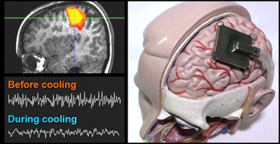Information Science 2017/10/06
―Towards development of a less-invasive and reversible treatment―
Using computational models, a research team of the Mathematical Informatics Laboratory, NAIST, has gained new insights into the mechanism by which focal brain cooling,
or lowering the temperature of a specific focal brain region, could potentially treat epileptic seizures.
Focal brain cooling of epileptic focus has extensively been studied in the previous decade and has shown potential for therapeutic treatment as an alternative for surgery especially for medically intractable epilepsy patients.
How cooling suppresses or terminates epileptic discharges, though, remained unclear. This study, in collaboration with Yamaguchi University and Kumamoto University,
proposed a computational model that can reproduce electrocorticogram from in vivo cooling experiments with rats induced with epilepsy.
A neural mass model was utilized to simulate epilepsy in the animal experiments.
Temperature dependence of the model is then formulated in order to capture how epileptic discharges are suppressed or terminated when cooling is applied.
The formulation involved temperature dependence in both the synaptic and the intrinsic firing processes of the neural mass model,
the physiological implications of which have been validated in several animal studies. As a result,
it is shown that the temperature dependence in the synaptic and intrinsic firing processes determines whether epileptic discharges can be terminated or only suppressed.
We hope that the model will be used in the future for thermal neuromodulation of epileptic seizures, when detected, via an implantable cooling device.
Research Article
Soriano J, Kubo T, Inoue T, Kida H, Yamakawa T, Suzuki M, and Ikeda K. (2017) Differential temperature sensitivity of synaptic and firing processes in a neural mass model of epileptic discharges explains heterogeneous response of experimental epilepsy to focal brain cooling. PLoS Comput Biol 13(10): e1005736.Available from http://journals.plos.org/ploscompbiol/article?id=10.1371/journal.pcbi.1005736
DOI: https://doi.org/10.1371/journal.pcbi.1005736





